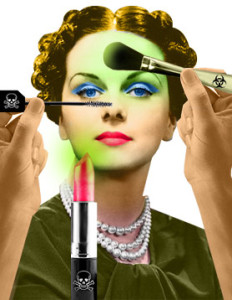By Marie Be
Guest Writer for Wake Up World
Most consumers assume that because a product is on a shelf, it must be safe. To explore this common assumption, let’s have a closer look at the cosmetic industry and the biology of the skin.
During the last half-century, the cosmetic industry has created the illusion that it is possible to apply toxic chemicals to their skin without poisoning their body. This allows the consumers to feel safe by wrongly believing that the skin is impermeable.
The fact is, the skin is a dynamic, living, multilayered bio-membrane which is porous at the microscopic level. The basic functions of the skin are respiration, absorption and elimination, all of which involve a dynamic exchange between the internal and external environments (nutrition in and wastes out).
The process by which a substance is transported across the skin and taken up into the living tissue of the body is known as dermal absorption [1]. On contact with the skin, cosmetic ingredients penetrate into the stratum corneum, the first layer of the skin. It subsequently reaches the viable epidermis, the dermis and the vascular system. During the absorption process, cosmetic compounds may also be subject to biotransformation [2].
[pro_ad_display_adzone id=”110028″]
The skin absorbs that which is applied on its surface directly into the bloodstream and lymphatic system, so unlike toxins taken in through the digestive system, toxins absorbed through the skin bypass the body’s natural defense mechanisms [3]. In fact, recent studies have shown that we may actually acquire more toxins through skin absorption than through the foods we eat [4].
So let’s take a closer look at the cosmetic industry.
The Cosmetic Industry
A History of Subsidies, FALSE SCIENCE & Under-Regulation
In the 1950s, government subsidies incentivized companies to process oil byproducts into synthetic chemicals and resins. Capitalizing on these generous subsidies, the cosmetic industry hired chemical engineers to design their products, with the resulting synthetic substances sold as body and skin ‘care’ products. The cosmetic industry created the misconception that the skin is impervious, and regulations misleadingly classify oil cosmetics as ‘external’ products [5] – ignoring the effects of dermal chemical absorption.
The cosmetic industry has high interest in making sure that the public feels safe. Over the last half-century, carefully seeded mis-information about the properties of our skin has created a false “common knowledge”, leading the public (particularly North America and Japanese markets) to believe the skin is a barrier. If it were widely known that the skin actually absorbs everything we apply to it, cosmetics would be classified as an internal product and be subject to far stricter regulations. But, to this day, cosmetics are classified as external products, allowing the cosmetic industry to be self-regulated [6].
Ingredients are reviewed by the Cosmetics Ingredient Review (CIR) panel, established and funded by the cosmetics industry trade association itself. In the last 30 years, less than 20% of the ingredients used in cosmetics were reviewed for safety; all but some exceptions were deemed safe. Most companies do their own testing, but these studies typically look for short-term health effects such as swelling and rashes. Although mountains of scientific evidence link chemical exposure to afflictions such as cancer, learning disabilities, autism, asthma, infertility, birth defects, no consideration is given to the long-term effects of cumulative chemical mixtures found in cosmetics – including known toxins such as lead.
In 2007, the Campaign for Safe Cosmetics commissioned tests of 33 top-selling red lipsticks at an independent lab and found lead in 61% of them. Follow-up tests by U.S. FDA detected even higher levels of lead than in the tests commissioned by the Campaign for Safe Cosmetics in all 20 lipsticks tested. Highest lead levels were in top-selling brands L’Oreal, Maybelline, Cover Girl and Revlon. [13]
And it seems even children are affected by the industry’s under-regulation.
In 2009, independent testing of children’s face paints commissioned by the Campaign for Safe Cosmetics found 10 out of 10 products tested contained lead. [14]
In 2003, the European Union banned from cosmetics approximately 1,400 chemicals that are known to or suspected of causing cancer, genetic mutation or birth defects. The U.S. and Canada has banned only eight [7]. More than 500 products sold in the U.S. contain ingredients banned in cosmetics in Japan, Canada or the European Union [8]. Let’s not mention the toxins in pharmaceutical cleansers and make-up ‘removers’…
Is this a major oversight on the part of government health regulators? Or are these loopholes carefully designed, facilitating a dangerous billion dollars industry?
Either way, the cosmetic industry is selling toxic chemicals as ‘personal care products’ without adequately reviewing their ingredients or monitoring the long term health effects of chemical absorption.
So what are the affects?
Health and Environmental Impact of Petrochemical Cosmetics
U.S. researchers identified 10,500 industrial chemicals used as cosmetic ingredients, including carcinogens, pesticides, reproductive toxics, endocrine disruptors, plasticizers, degreasers and surfactants.
The average individual is exposed to over a hundred cosmetic chemicals a day. Women use an average of 12 personal care products a day containing about 180 chemicals; men use an average of 6 products containing about 85 chemicals [9]. Many of these chemicals act like estrogen, disturbing natural body functions, turning hormone signals on and off. Chemicals add up in the body as the metabolic and detoxification systems become overwhelmingly overloaded. As they accumulate, they exponentially increase each other’s detrimental health impacts [10].
As if that wasn’t enough, chemicals are passed on from mother to child in utero. Researchers analyzed the umbilical cord blood of newborn infants in Europe and North America, and detected an average of 200 industrial cosmetic chemicals in every newborn tested. Nowadays, babies are contaminated with man-made toxins before they are even born [11].
[For more on this topic, please check out contributing writer Raluca Schachter’s article Why Children Increasingly Share Their Parents’ Toxicity and Nutritional Deficiencies]
The chemicals used in cosmetics end up polluting not only our bodies, but also our communities. Research indicates that toxic cosmetic ingredients end up in our environment from production and disposal. They end up in our drinking water, rivers and lakes and even in the sewage sludge spread on our food-producing farm fields. Triclosan, for example, is a common chemical used in anti-bacterial hand soap, toothpaste, facewash, deodorant, a host of personal care products; it pollutes the human body but also breaks down into persistent substances that are highly toxic to wildlife and aquatic environments [12].
Without any long-term health research and tangible regulations, cosmetics products are basically a giant experiment, conducted at our expense. Although the cosmetic and skin care industry is booming, the long-term effects on the body and environment of associated chemical accumulation remain untested.
[pro_ad_display_adzone id=”110030″]
Consumer Safety
The petrochemical cosmetic industry is growing by leaps and bounds. Since regulations do not require full disclosure of petrochemicals in their products, it is up to you to inform yourself so that you can best protect the health of your family.
The best way to read a personal care product ingredients list is to read each ingredient as if it were something that you might put in your mouth. Since your skin is absorbent, ingredients should be as pure as the foods we eat. If you wouldn’t eat it, don’t put it on your skin!
Read the ingredients, but be aware that companies are not required to disclose the constituent chemical ingredients that make up “fragrance”, or list impurities and contaminants. Thanks to these loopholes, hundreds of chemicals are not listed on a package labels at all. If in doubt, err on the side of caution.
Be wary of label advertising. The listing of many botanicals on the front label of a product that may contain only one or two drops of a highly processed herb extract is known in the cosmetic trade as “window dressing.” This tactic is used to distract you from all of the chemicals that are listed on the ingredient label located in small print on the back. Cosmetic companies know that most people don’t have the time, the interest, or the education to read and understand ingredient labels.
Look for products that source organic and fair trade ingredients, and build a rapport with businesses you trust, and health food stores and websites that test and review products for safety. Remember, the manufacturer that gives you the most information about its product is usually the manufacturer you can trust.
There are companies out there that provide chemical-free products, and websites that review for safety. And some producers go beyond simply being safe…
At EarthSun, we aim to set a new standard for the body care industry. We support sustainable and ‘beyond fair’ trade farming, sourcing only the highest food grade quality, raw and organic ingredients. And since we understand how absorbent the skin actually is, we proudly add detoxing, healing and health-enhancing ingredients to our all-natural body products.
I hope you found this article informative. If you would like more information, you are more than welcome to visit me at Earth for the Sun.
Resources:
- [1] Schaefer H., and Redelmeier T.E., (1996). Skin Barrier: Principles of Percutaneous Absorption. Karger, Basel.
- [2] Brandau et Lippol, (1982). Dermal and Transdermal Absorption, Wissenschaftliche Verlag Gesellschaft, 257 p., Stuggart, 1982.
- [3] Bronaugh R.L., Wester R.C., Bucks D., Maibach H.I., and Sarason R., (1990). In vivo percutaneous absorption of fragrance ingredients in rhesus monkeys and humans. Fd. Chem. Toxic.28: 369-373.
- [4] EPA (United States Environmental Protection Agency) (1996) Health Effect Test Guidelines. Dermal Penetration (EPA 712-C-98-350).
- [5] The Story of Cosmetics. www.safecosmetics.org/SoCos_footnoted_script
- [6] www.cosmeticsdatabase.org and www.ewg.org/skindeep
- [7] Official Journal of European Union – Directive 2003/15/EC of The European Parliament and of The Council. www.safecosmetics.org/EU-Cosmetics-Directive_2003
- [8] Environmental Working Group – Cosmetics Safety Myths Debunked. www.ewg.org/cosmetics-safety-8-myths-debunked
- [9] Environmental Working Group – Exposures Add Up. www.ewg.org/exposures-add-up-survey-results
- [10] The Campaign for Safe Cosmetics – Low-Dose Exposures. www.safecosmetics.org/article.
- [11] Environmental Working Group – Pollution in Minority Newborns: Executive Summary. www.ewg.org/research/executive-summary
- [12] Science Daily – Household Detergents, Shampoos May Form Harmful Substance in Wastewater. www.sciencedaily.com
- [13] Lead in Lipstick. www.safecosmetics.org/lipstick
- [14] Heavy Metals in Face Paint. www.safecosmetics.org/prettyscary
Previous articles by Marie:
- BURN: Health Impacts of Sunscreen Found to be Worse Than UV Damage!
- 3 Years After Fukushima: Behind the Skewed Data and Vested Interests
About the author:
 Marie Be’s inspiration comes from her mom who always challenged common assumptions and sought to understand for herself the major issues concerning her family and the choices she made on their behalf. She raised Marie and her brother in a rural environment, feeding them the best organic foods, and focused on building strong immune systems in her children through the use of natural plants, herbs and minerals.
Marie Be’s inspiration comes from her mom who always challenged common assumptions and sought to understand for herself the major issues concerning her family and the choices she made on their behalf. She raised Marie and her brother in a rural environment, feeding them the best organic foods, and focused on building strong immune systems in her children through the use of natural plants, herbs and minerals.
As a fiery teenager, Marie travelled the world in search of purpose and dreamed of positively influencing our society. While earning her first two degrees, in architecture and sustainable development, she worked for Greenpeace and many other organizations of change. Her experience taught her that change cannot be imposed; she now aims at inspiring individuals through education and awareness.
Marie moved to Vancouver to undertake a Masters in Regenerative Sustainability under the supervision of a Nobel Peace Prize recipient. Teaching workshops on well-being, she started observing a widespread desire in our society for both physical and environmental health and sustainability. Feeling the winds of change, Marie founded Earth for the Sun.
Earth for the Sun was inspired by nature, the source of life. By tuning in that source, by acquiring knowledge on ancient herbal traditions as well as new technologies, Marie believes it is possible to use nature’s intelligence and deliver simple and effective health products. Check out Earth for the Sun for more information.
[pro_ad_display_adzone id=”110027″]








